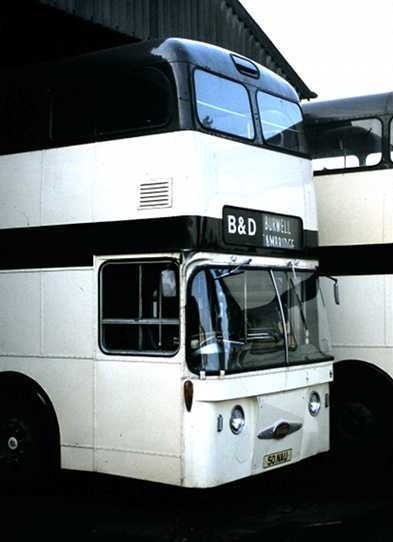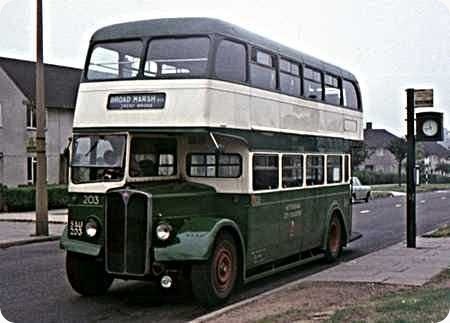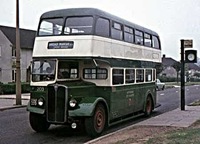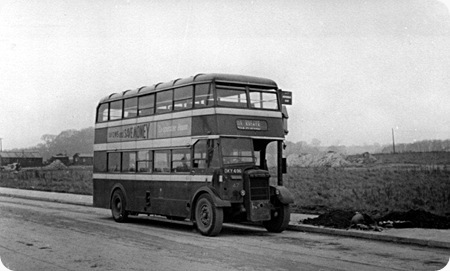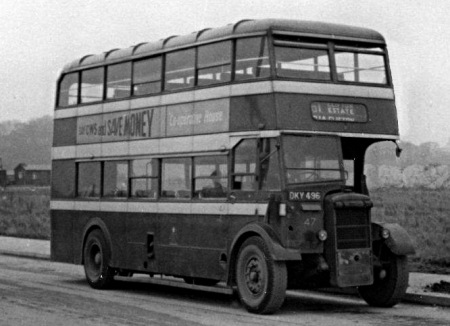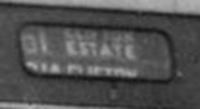Nottingham City Transport – Daimler Fleetline – 62 NAU – 62

Photograph by ‘unknown’ if you took this photo please go to the copyright page.
Nottingham City Transport
1962
Daimler Fleetline CRG6LX
Park Royal H77F
October 2012 saw the 50th anniversary of the introduction of rear engined buses by Nottingham City Transport. The subject of the image is a Daimler Fleetline CRG6LX, fleet number 62, registration number 62 NAU. It had a Park Royal H77F body. It was delivered new to NCT on 12.12.62 and entered service on 18.12.62. It is seen here at the Farnborough Road/Pastures Avenue, Clifton Estate, terminus of service 68 when new and is loading passengers for a journey to Broad Marsh Bus Station in Nottingham via Clifton Bridge (service 68 journeys operated by South Notts and West Bridgford UDC ran via Trent Bridge). The large Daimler badges with which 62 and others of the batch (nos 46 to 63) were fitted when delivered were quickly removed and replaced by a Daimler scroll, as there was an air intake at this location and the large badge partially obscured this. This year also saw, on 29th October, the 60th anniversary of the introduction of the joint service operated by NCT, South Notts and WBUDC to Clifton Estate, although the 68 was not introduced until 1956 when the initial development of the estate was nearing completion.
Photograph and Copy contributed by Michael Elliott
A full list of Daimler codes can be seen here.
04/12/12 – 15:44
With reference to the posting above of 62 NAU when new, here is a view of one of her sisters, 50 NAU, towards the end of her working life. She is seen peering out of the doorway of the Burwell & District depot in Burwell on 25 August 1978. Nottingham’s livery always was one of the smarter ones and the view of 62 does it credit.
Pete Davies
04/12/12 – 16:58
This is a good example of a well applied livery helping to ease the rather brutal lines of the ‘Orion’ derived body design. The tasteful layout of the fleet name and the red wheels set off the green very well. I remember one of this batch coming to Rochdale to be shown to the Transport Committee in the Autumn of 1962. It was probably brand new and was parked outside the Town Hall along with the light blue AEC Renown demonstrator and the Leyland Atlantean demonstrator in Maidstone & District style green and cream. It was just after the 1962 Commercial Motor Show at which the Renown made its debut. Rochdale chose the Fleetline for its next double deck purchases.
Philip Halstead
05/12/12 – 07:39
Interestingly in Pete’s picture 50 NAU has a much more modern windscreen and front panel than 62 yet has retained, or had re-applied, the large Daimler badge.
Eric Bawden
05/12/12 – 07:40
As has been mentioned before on this site, Northern General allowed their subsidiaries a certain amount of independence when it came to vehicle buying and spec. Between 1960 and 62 Percy Main acquired 25 Leyland PDR1/1 Atlanteans, ‘9 Metro Cammell and 16 Roe’ but then while most of the rest of NGT were still ordering Leyland’s Percy Main switched to CRG6LX Daimler Fleetlines. Between 1963 and 68 they took delivery of 35 in total, the first two batches of 10 and 5 were MCW’s and the remaining 20 arrived in three batches of 7 – 3 and 10 and were all Alexander bodied. I could be wrong about this, but I believe orders for more were cancelled when NBC came into being, but from my experience of driving both the Fleetline was a far superior vehicle to the Atlantean, but like the AEC Reliance, the Bristol REL and the FRM Routemaster they didn’t fit into NBC and BL’s ‘master plan’
Ronnie Hoye
05/12/12 – 08:03
50 NAU was fitted with the 1964 pattern windscreen and dash arrangement following accident damage circa 1968/69. From memory it ran off the road on Carlton Hill and hit a house. At the time of the accident it was allocated to Bilborough Depot and was working a ‘works special’.
Michael Elliott
05/12/12 – 09:19
Peter mentioned he was sure someone would comment upon the newer front end on the Burwell vehicle. It looks to me like a ‘Manchester’ lower panel, as Birmingham had on some of theirs towards the end of 1966, but I had no idea why it should have been treated. Thank you, Michael, for enlightening us.
Ronnie, interesting comment about the freedom of operation in the NGT group. I suppose it is hardly surprising that the same degree of freedom seems to have filtered throughout what is now the ‘Go Ahead’ group. There has been discussion on this site in the past about the NBC and BL ‘master plan’, and we all know what happened to both!
Pete Davies
05/12/12 – 10:40
Philip, slightly off topic but was it my imagination that the lower deck window line on all of Rochdale’s Fleetlines was higher than normal or were the wheels smaller?
Compare www.flickr.com/
with www.sct61,org.uk/
Back to Nottingham, I often wonder if the department’s development of their own unique body style which, like the various developments or not were at least different and interesting to look at, was a reaction to the bland Orionism of early rear engined bodies or just a determination to be different.
Phil Blinkhorn
05/12/12 – 10:57
Pete, that’s not a Manchester panel, see www.sct61.org.uk/ for the differences
Phil Blinkhorn
05/12/12 – 11:55
Thank you, Phil B
Pete Davies
05/12/12 – 17:54
The Daimler badge fitted to 50 NAU was not the original `large` one, but the shorter version, common on most Fleetlines.
I found the appropriate part no. in the Fleetline parts list and ordered 4 from the local BL parts dealer, they duly arrived, price around £18 + VAT and were fitted to 50/53/61/3 NAU.
By the time 56 NAU arrived at Burwell, (via Ensign) I had secured a supply of the original `longer` badges that had been supplied to Walsall Corporation, but were too long to fit on the rounded front panels of their `short` Fleetlines.
I won`t reveal how much I paid, but it was less than £18 each! (I still have one wrapped in the original VERY sticky waxed paper)
Jim Neale
05/12/12 – 17:55
To answer Phil on the Rochdale Fleetlines, yes you are right they did have the lower saloon window line about a foot higher than normal. The reason was that despite the Fleetline having a drop-centre rear axle, Rochdale adopted a two step entrance with a high floor line throughout the lower saloon. In my view this had two negative affects. Firstly, it made the buses look very ungainly from a three-quarter front view and secondly, as the lower driving position was retained it put the driver in a very intimidating low position against boarding passengers. This must have been an especially uncomfortable position for drivers when later on these buses were used for opo with fare paying passengers towering above them. To me these were some of the ugliest buses ever built and massive contrast to the previous Regent V’s.
Philip Halstead
06/12/12 – 07:12
Thanks Philip. I always thought they were odd. I used to see them regularly in the 1960s and 1970s but was normally driving past them, so couldn’t study them closely, and I never rode on one.
They certainly were ungainly looking – not helped by the acres of cream paint, the SELNEC livery, for once did help a bit.
Phil Blinkhorn
06/12/12 – 11:46
Picking up the thread of Philip H’s comments on bad design. The safest layout for stairs on any type of double decker are those were you ascend towards the front of the vehicle. Worst that can happen if the driver anchors up sharply is that anyone on the stairs will either fall forwards if they’re going up, or end up on their backside if coming down, but it’s unlikely they will end up in a heap at the bottom. That said, for some reason know best to whoever ordered them, the second batch of MCW Daimler Fleetline’s delivered to Percy Main JFT 276/80, had the stairs going the other way, in the same case scenario people on the stairs will fall backwards or go head first base over apex, but the only way they can go is in the direction of down. As well as in my opinion being dangerous, the layout also reduced the seating capacity by three, so a bad idea all round I would have thought
Ronnie Hoye
03/10/20 – 10:34
I seem to remember that, when still quite new, 62 NAU became "The Pork Farms bus", with all advertising space (including LT-style adverts flanking the destination screen) devoted to the local Pork Pie manufacturer. Either this one or 63 carried a green/cream livery applied differently for a while – green lower panels/between deck panels and cream window surrounds and roof, if my memory serves me correctly.
I have just searched for on-line photos of 63 NAU, and it was this one that had the different (experimental?) livery application – proved by a Roy marshal picture in the Transport Library.
Terry Walker
Quick links to the - Comments Page - Contact Page - Home Page
